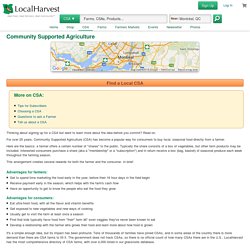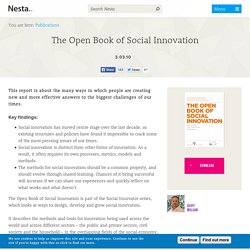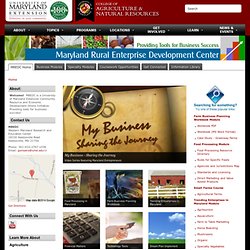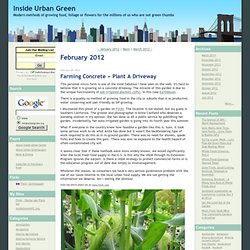

Community-supported agriculture. Community-supported agriculture (CSA; sometimes known as community-shared agriculture) is an alternative, locally-based economic model of agriculture and food distribution. A CSA also refers to a particular network or association of individuals who have pledged to support one or more local farms, with growers and consumers sharing the risks and benefits of food production. CSA members or subscribers pay at the onset of the growing season for a share of the anticipated harvest; once harvesting begins, they receive weekly shares of vegetables and fruit, in a vegetable box scheme. Often, CSAs also include herbs, honey, eggs, dairy products and meat, in addition to conventional produce offerings.In theory a CSA can provide any product to its members, although the majority of CSA operations tend to provide produce, fruits, and various edibles.
Some CSA programs also include cut flowers and various ornamental plants as part of their weekly pickup arrangement. History[edit] Structure[edit] Community Supported Agriculture. Thinking about signing up for a CSA but want to learn more about the idea before you commit?

Read on. For over 25 years, Community Supported Agriculture (CSA) has become a popular way for consumers to buy local, seasonal food directly from a farmer. Here are the basics: a farmer offers a certain number of "shares" to the public. Typically the share consists of a box of vegetables, but other farm products may be included. Interested consumers purchase a share (aka a "membership" or a "subscription") and in return receive a box (bag, basket) of seasonal produce each week throughout the farming season.
This arrangement creates several rewards for both the farmer and the consumer. Advantages for farmers: Get to spend time marketing the food early in the year, before their 16 hour days in the field begin Receive payment early in the season, which helps with the farm's cash flow Have an opportunity to get to know the people who eat the food they grow Advantages for consumers: Variations Shared Risk. Www.nesta.org.uk/library/documents/Social_Innovator_020310.pdf. This report is about the many ways in which people are creating new and more effective answers to the biggest challenges of our times.

Key findings: Social innovation has moved centre stage over the last decade, as existing structures and policies have found it impossible to crack some of the most pressing issues of our times. Social innovation is distinct from other forms of innovation. As a result, it often requires its own processes, metrics, models and methods.The methods for social innovation should be a common property, and should evolve through shared learning. Chances of it being successful will increase if we can share our experiences and quickly reflect on what works and what doesn’t.
Www.bankofideas.com.au/Downloads/Rural_Revitalisation.pdf. Pubs.ext.vt.edu/310/310-100/310-100_pdf.pdf. Conservancy.umn.edu/bitstream/51859/1/Resources_for_Beginning_Farmers.pdf. Agmarketing.extension.psu.edu/begfrmrs/FindingANiche_casestudy.pdf. Www.thegreenhorns.net/wp-content/files_mf/1335219697greenhorns_guide_sept2010_web.pdf. Saltcreekfarm.homestead.com/Farm_Guide_2010_ZINE_FORMAT.pdf.
Pods.dasnr.okstate.edu/docushare/dsweb/Get/Document-2981/E-982.pdf. Www.pickyourown.org/resources/Entertainment Farming and Agri-Tourism Business Management Guide.pdf. Agmarketing.extension.psu.edu/business/pdfs/sowantfarmr.pdf. Njsustainingfarms.rutgers.edu/Agritourismwp/_pdf/Evaluating_a_Farming_Enterprise.pdf. Www.cefs.ncsu.edu/whatwedo/foodsystems/newfarmers/newfarmertoolboxbusinessplanning.pdf.
Www.mredc.umd.edu/Documents/Agritourism/EntrepreneursGuide.pdf. Welcome to the Maryland Rural Enterprise Development Center (MREDC), a University of Maryland Extension Community Resource and Economic Development Online Initiative.

MREDC, a one-stop-shop for the 21st century agricultural/natural resource entrepreneur, provides successful rural business innovation strategies for your farm business plan, and your production and management techniques. Learn anywhere by using the many distance learning tools delivered on MREDC in many interactive formats that are organized in modules. These unique modules and tools are designed to help you get information quickly and make informed decisions.
Whether your business is large or small, established or just getting launched, if it involves any aspect of agricultural or natural resource production and marketing, the Maryland Rural Enterprise Development Center has the tools and information you need to help you succeed. February 2012. ACGA photo In yesterday's post about the Rooftop Garden Project in Montreal, I questioned why I do not know of any community garden in the U.S. doing what they do to serve their surrounding community.

We have more than 600 community gardens serving less than 1% of the population here in New York City. To my knowledge, there is not one of them offering modern method options to growing in the ground. Long time New Yorkers will remember the ConEd motto "Dig We Must". That seems to have stuck with the community gardeners. In my view, it is not enough to simply provide a small plot of land to a limited few when there are modern methods that are portable and can serve an unlimited number of people in the community. Why should a community garden be synonymous with dirt gardening only and be anchored to a scarce parcel of city land? Following are two community gardening guides among many on the web. Community gardens could be and should be educational leaders to their local communities. Docs/starting_a_community_garden.pdf.